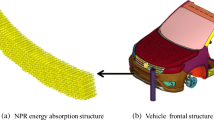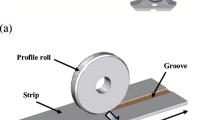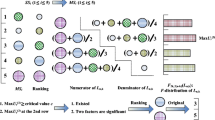Abstract
The design of blast-resistant vehicle provides an appropriate level of protection for the vehicle and occupants against the serious threat from landmine and improvised explosive devices (IED). Mathematically, the objective of this research is to optimize the configuration of light armored vehicle installed multilayer honeycomb sandwich structures (MHSS), shock-mitigating seat and seat belt, and cope with the challenge of highly computational cost on dealing with the large scale, multi-parameter, nonlinear and fluid-structure interaction simulation models. Multi material Arbitrary Lagrangian-Eulerian (MM-ALE) method is used to obtain the high-precision vehicle responses and occupant injuries under blast wave. The baseline model validated by the blast test is built, and the optimization model for blast-resistant vehicle is defined. Then, identifying important design parameters accurately is so difficultly when sufficient samples are not provided due to the expensive computational cost, and it’s inappropriate to screen parameters with inconsistent sequence of variable sensitivities for occupant injuries. Factor analysis based multi-parameter optimization (FAMO) is proposed to reduce the computational cost on improving the blast resistant performance of vehicle. The normal-boundary intersection (NBI) and the R 2 metric are used to obtain optimal compromise solution which noticeable reduced the peak value of occupant injuries, and the physical insights which drive the optimal solution to reduce the occupant injuries is analyzed. Additional studies are conducted on comparing between proposed algorithm and the conventional algorithm, including shape of the Pareto front, optimal compromise solution, design variables and responses.















Similar content being viewed by others
Abbreviations
- t h1 :
-
Thickness of front face-sheet
- t h2 :
-
Thickness of interlayer
- t h3 :
-
Thickness of back face-sheet
- t b1 :
-
Thickness of floor board
- t b2 :
-
Thickness of shock-mitigating seat bracket
- k s :
-
Stiffness of shock absorber
- c s :
-
Damping coefficient of viscous damper
- E s :
-
Young’s modulus of seat belt
- X :
-
Matrix of design variable
- C :
-
Covariance matrix of X
- F :
-
Matrix of factor
- A :
-
Loading matrix of factor
- ε :
-
the error factor
- p :
-
Number of design variables
- m :
-
Number of factors
- n :
-
Number of responses
- λ :
-
Multiple parameter of P
- Κ:
-
Correlation matrix
- Λ:
-
Partial correlation matrix
- ρ-value:
-
Level ofχ 2 distribution
References
An H, Green DE, Johrendt J (2010) Multi-objective optimization and sensitivity analysis of tube hydroforming. Int J Adv Manuf Technol 50:67–84
Bäck T (1996) Evolutionary algorithms in theory and practice: evolution strategies, evolutionary programming, genetic algorithms. Oxford University Press, Oxford
Bailey AM, Christopher JJ, Salzar RS, Brozoski F (2015) Comparison of hybrid-III and postmortem human surrogate response to simulated underbody blast loading. J Biomech Eng 137(5):1–10
Baranowski P, Malachowski J (2015) Numerical study of selected military vehicle chassis subjected to blast loading in terms of tire strength improving. Bull Pol Acad Sci Techn Sci 63(4):867–878
Chen W, Hao H (2012) Numerical study of a new multi-arch double-layered blast-resistance door panel. Int J Impact Eng 43(5):16–28
Cheng M, Dionne J-P, Makris A (2010) On drop-tower test methodology for blast mitigation seat evaluation. Int J Impact Eng 37(12):1180–1187
Cho H, Bae S, Choi KK, Lamb D, Yang R-J (2014) An efficient variable screening method for effective surrogate models for reliability-based design optimization. Struct Multidiscip Optm 50(5):717–738
Chung Kim Yuen S, Langdon GS, Nurick GN, Pickering EG, Balden VH (2012) Response of V-shape plates to localised blast load: experiments and numerical simulation. Int J Impact Eng 46(4):97–109
Dillon W, Goldstein M (1985) Multivariate analysis: methods and applications. J Bus Econ Stat 3(4):85–87
Dong YP, Lu ZH (2012) Analysis and evaluation of an anti-shock seat with a multi-stage non-linear suspension for a tactical vehicle under a blast load. Proc Inst Mech Eng D J Automob 226(8):1037–1047
Du Y, Ma L, Zheng J, Zhang F, Zhang A (2015) Coupled simulation of explosion-driven fracture of cylindrical shell using SPH-FEM method. 14th International Conference on Pressure Vessel Technology (ICPVT) Chinese Pressure Vessel Inst, Shanghai, Peoples Republic of China
Falkenreck TE, Boellinghaus T (2016) Blast resistance of high-strength structural steel welds. Weld World 60(3):475–483
Fan H, Bergel GL, Li S (2016) A hybrid peridynamics–SPH simulation of soil fragmentation by blast loads of buried explosive. Int J Impact Eng 87:14–27
Gama BA, Bogetti TA, Fink BK, Yu C-J, Dennis Claar T, Eifert HH, John W, Jr G (2001) Aluminum foam integral armor: a new dimension in armor design. Compos Struct 52:381–395
Grujicic M, Arakere G, Bell WC, Haque I (2009) Computational investigation of the effect of up-armouring on the reduction in occupant injury or fatality in a prototypical high-mobility multi-purpose wheeled vehicle subjected to mine blast. Proc Inst Mech Eng D J Automob 223(7):903–920
Guo QT, Zhou YB, Wang XH, She L, Wei R (2015) Numerical simulations and experimental analysis of a vehicle cabin and its occupants subjected to a mine blast. Proc Inst Mech Eng D J Automob 230(5):623–631
Henchie TF, Chung Kim Yuen S, Nurick GN, Ranwaha N, Balden VH (2014) The response of circular plates to repeated uniform blast loads: an experimental and numerical study. Int J Impact Eng 74:36–45
Johnson TE, Basudhar A (2015) A metamodel-based shape optimization approach for shallow-buried blast-loaded flexible underbody targets. Int J Impact Eng 75:229–240
Mechri HE, Capozzoli A, Corrado V (2010) USE of the ANOVA approach for sensitive building energy design. Appl Energy 87(10):3073–3083
Nato (2011) Procedures for evaluating the protection level of logistic and light armored vehicles-Mine Threat. AEP-55: 74
Newell N, Salzar R, Bull AM, Masouros SD (2016) A validated numerical model of a lower limb surrogate to investigate injuries caused by under-vehicle explosions. J Biomech 49(5):710–717
Ning LP, Georgiou TT, Tannenbaum A, Boyd SP (2015) Linear models based on noisy data and the Frisch scheme. SIAM Rev 57(2):167–197
Pandelani T, Reinecke D, Beetge F (2010) In pursuit of vehicle landmine occupant protection: Evaluating the dynamic response characteristic of the military lower extremity leg (MiL-Lx) compared to the Hybrid III (HIII) lower leg, CSIR 3rd Biennial Conference 2010, South Africa
Qi C, Yang S, Yang L-J, Wei Z-Y, Lu Z-H (2013) Blast resistance and multi-objective optimization of aluminum foam-cored sandwich panels. Compos Struct 105:45–57
Ramasamy A, Hill AM, Hepper AE, Bull AM, Clasper J (2009) Blast mines: physics, injury mechanisms and vehicle protection. J R Army Med Corps 155(4):258–264
Ramasamy A, Hill AM, Masouros SD, Gordon F, Clasper JC, Bull AM (2011) Evaluating the effect of vehicle modification in reducing injuries from landmine blasts. An analysis of 2212 incidents and its application for humanitarian purposes. Accid Anal Prev 43(5):1878–1886
Rigoni E (2004) NBI-NLPQLP Scheduler. ESTECO Technical Report No. 2004–003
Ryberg A-B (2013) Metamodel-based design optimization-a mutidisciplinary approch for automotive structures. Linköping University, Linköping
Shi L, Yang RJ, Zhu P (2012) A method for selecting surrogate models in crashworthiness optimization. Struct Multidiscip Optim 46(2):159–170
Sriram R, Vaidya UK (2006) Blast impact response of aluminum foam sandwich composites. J Mater Sci 13(41):4023–4039
Van Der Horst MJ, Simms CK, Van Maasdam R, Leerdam PJC (2004) Occupant lower leg injury assessment in landmine detonations under a vehicle. Solid Mech Appl 124:41–49
Vlahopoulos N, Zhang G (2010) Validation of a Simulation Process for Assessing the Response of a Vehicle and Its Occupants to an Explosive Threat. The 27th Army Science Conference (ASC), Orlando
Wang J (2001) Simulation of landmine explosion using LS-Dyna3d software: benchmark work of simulation of explosion in soil and air. Defense Science & Technology Organization no. DSTO-TR-1168, Australia
Wang X, Shi L (2014) A new metamodel method using Gaussian process based bias function for vehicle crashworthiness design. Int J Crashworthines 19(3):311–321
Wang X, Tang Y, Chen X, Zhang Y (2010) Design of Experiment in global sensitivity analysis based on ANOVA high-dimensional model representation. Commun Stat Simul Comput 39(6):1183–1195
Wang X, Tang Y, Zhang Y (2011) Orthogonal arrays for the estimation of global sensitivity indices based on ANOVA high-dimensional model representation. Commun Stat Simul Comput 40(9):1324–1341
Wu J, Wong ACM (2003) A note on determining thep-value of Bartlett's test of homogeneity of variances. Commun Stat Theory Methods 32(1):91–101
Yang RJ, Wang N, Tho C, Bobineau J (2005) Metamodeling development for vehicle frontal impact simulation. Asme J Mech Des 127(5):1014–1020
Yang Y, Liou WW (2013) Shock wave impact simulation of a vehicle occupant using fluid/structure/dynamics interactions. Int J Impact Eng 52(2–3):11–12
Zhu F, Zhao L, Lu G, Wang Z (2008) Deformation and failure of blast-loaded metallic sandwich panels—experimental investigations. Int J Impact Eng 35(8):937–951
Acknowledgements
This work is funded by the National Natural Science Foundation of China (grant number: 51405232). The authors would like to thank the Nanjing University of Science &Technology for supporting and providing the relational equipment.
Author information
Authors and Affiliations
Corresponding author
Rights and permissions
About this article
Cite this article
Wei, R., Wang, X., Zhang, M. et al. Application of dimension reduction based multi-parameter optimization for the design of blast-resistant vehicle. Struct Multidisc Optim 56, 903–917 (2017). https://doi.org/10.1007/s00158-017-1696-2
Received:
Revised:
Accepted:
Published:
Issue Date:
DOI: https://doi.org/10.1007/s00158-017-1696-2




